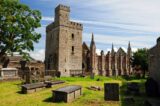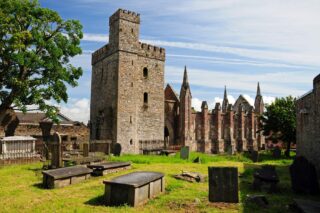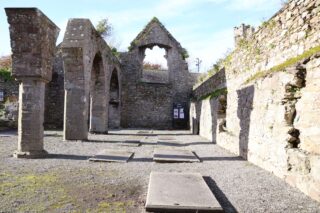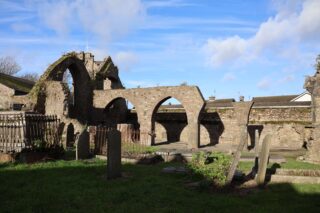Selskar Augustinian Priory
An abbey with a tragically romantic story associated with it
Unguided sitesFógra
WARNING: It should be noted that these sites are unguided and a level of care and caution should be maintained during all stages of your visit. The Office Of Public Works (OPW) will not be held responsible for any damages, injuries, or losses that occur
Selskar Augustinian Priory
The Priory of the Canons Regular of St. Augustine Priory of SS Peter and Paul, commonly referred to as Selskar Abbey, represents the main Anglo-Norman foundation in Wexford town. It is believed to have been established by Alexander de la Roche of Artramont. The origins of the site are subject to debate, while several sources indicate that it may have housed an earlier Christian community, predating the Viking incursions, around 800 AD, other evidence suggests the presence of a pre-Christian temple dedicated to the Norse god Odin.
The architectural remnants of the abbey that have survived date back to before 1240, when a synod was convened there by John de St. John, Bishop of Ferns. Other sources state in 1172 Henry II also spent Lent at the abbey, as he did penance for having Thomas Becket beheaded, and was the location where the first Anglo-Irish treaty was signed.
The church, characterized by its double nave, has suffered significant destruction, with only the gables and remnants of the west windows remaining intact. Notably, a small carved stone head, referred to as a “grotesque,” can be found above these windows. Additionally, the remnants of an arcade, comprising four pointed arches, are visible, separating the church’s aisles. The south wall has largely disappeared, although it originally featured four windows with square hood-mouldings. The north wall now defines the boundary of the graveyard. A fortified tower, likely added in the late 14th century, is well-preserved and its quoins and windows are made from Dundry stone. It is important to note that the church is the only remaining structure of the abbey complex.
Historically, Selskar Abbey was frequently referred to as "juxta Wexford," indicating that a substantial portion of its grounds extended beyond the town’s boundaries. In the 1540s, following the dissolution of the monasteries, Selskar Abbey was recorded to possess a church, steeple (presumably the fortified tower), chancel, cemetery, dormitory, hall, four chambers, kitchen, dovecote, two stables, and various agricultural lands, granges, barns, orchards, and gardens, both within and outside the town walls. These possessions were interconnected by the Abbey Gate, which remains have undergone restoration. The gate resembles a small tower-house, with the gateway passing through its ground floor.
Following the dissolution, the abbey church was retained as a Church of Ireland place of worship, allowing it to escape the fate of many other churches in Wexford town, which were sold off as building materials—some of which were utilized to repair damage inflicted upon Wexford Castle by Oliver Cromwell’s artillery.
In 1826, the Church of Ireland decided to construct Selskar Church within the grounds of the original abbey, requiring the dismantling of certain parts of the abbey to accommodate the new church. The tower was refurbished and repurposed as a sacristy and belfry. However, in the 1950s, the decision was made to close Selskar Church in favour of St. Iberius Church, located in the town centre. The roof of the 19th century church reclassifying the structure as a ruin for tax purposes.
Selskar Abbey has many stories and legends attached to it dating back to its foundations, its believed founder Sir Alexander de la Roche’s son was a crusader knight and he became subject of a well-known romantic legend of Selskar, “the Wexford Knight set out for Jerusalem, he was engaged to be married but the call of arms he durst not tarry, and with many a sigh and many a tear bade his adieux to his affianced bride. Those were the days of chivalry, when valour, gallantry and religion were strangely blended. Laurels won on foreign plains – especially under the banner of the Cross – had a military fascination which we can nowadays ill understand. However, our young knight set out foreboding gladly his quick return covered with glory, and perhaps a few scars, from the holy fields. He assuaged the sorrows of his bride by promises of costly textures and roseate gems from the east – with precious relics form the Holy Sepulchre. Time passed on. At last a fatal rumour came crushing to the bridal heart. It was said the Wexford knight had fallen when or where it was not told, but boding silence seemed to seal the news. Months passed on and yet a year, no gladdening tidings came. Hope began to die within the maiden’s heart, and in her saddened soul she vowed that if another cycle passed untold to hide within the cloister wall. The boding year passed and with it no hopeful tidings from the Holy Land. In fulfilment of her vow the lady entered a convent and became a nun. When the war of Palestine were over, legion after legion returned to Europe, and unexpectedly among the bronzed Crusaders the knight of Wexford reached his castle safe and sound. On his arrival he hastened to the home of his bride but only to find his treasure had flown and to learn that the hand whereon he had hoped to clasp his gems had sought a nobler Spouse. In his anguish he sought solace of religion and following the example of his betrothed, entered the cloister of Selskar, exchanging the mailed trappings of his soldier for the habit of a monk.”[1]
Visit Historic Environment Viewer for more information on Selskar Priory
Protect our Past - Click here to read about the importance of protecting our country’s unique heritage sites
This national monument is protected in accordance with the National Monuments Acts 1930 to 2014
[1] Cullen, John B. “The Ancient Churches of the Town of Wexford.” The Journal of the Royal Society of Antiquaries of Ireland, vol. 5, no. 4, 1895, pp. 369–70.




